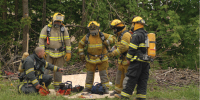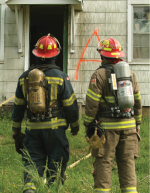
Features
Training
RIT training: How to develop your department’s rapid intervention team
We have all heard the term rapid
intervention team or RIT. Many fire departments have begun to train
their personnel in the concepts of rescuing downed, trapped or injured
firefighters. The concept of rapid intervention teams is not new. It
has been around for 10 to 15 years in the U.S. but has only begun to
infiltrate the Canadian fire service in the last five years. What was
once a trend is now a standard practice with many fire departments
implementing some kind of a RIT program.
July 18, 2008
By Mark van der Feyst
We have all heard the term rapid intervention team or RIT. Many fire departments have begun to train their personnel in the concepts of rescuing downed, trapped or injured firefighters. The concept of rapid intervention teams is not new. It has been around for 10 to 15 years in the U.S. but has only begun to infiltrate the Canadian fire service in the last five years. What was once a trend is now a standard practice with many fire departments implementing some kind of a RIT program.

|
| Photo by Mike Gutschon Mark van der Feyst instructs a group of firefighters from Beachville, Ont., in rapid intervention training. |
We have now adopted rapid intervention teams into NFPA standards such as 1500: Standard on Fire Department Occupational Safety and Health Program, 1710: Standard for the Organization and Deployment of Fire Suppression Operations, Emergency Medical Operations, and Special Operations to the Public by Career Fire Departments, and 1720: Standard for the Organization and Deployment of Fire Suppression Operations, Emergency Medical Operations and Special Operations to the Public by Volunteer Fire Departments. The Ontario Ministry of Labour’s Fire Service Section 21 Advisory Guidance Note 6-11 (35) also addresses the idea of establishing and using a rapid intervention team, but the question is who are they, really?
NFPA 1410: Standard on Training for Initial Emergency Scene Operations (2005) defines RIT as “Two or more fire fighters assigned outside the hazard area at an interior structure fire to assist or rescue at an emergency operation.” Ontario Fire Service Section 21 Advisory Guidance Note 6-11 (35) defines RIT as follows:
The Rapid Intervention Teams (R.I.T.) can either be:
- on-scene firefighters designated and dedicated to rapid intervention crews, or;
- on-scene firefighters performing other functions, but ready to deploy as rapid intervention teams if necessary.
 |
| Photo by Mike Gutschon Craig Cunningham from Mississauga Fire & Emergency Services (left) and Matt Wherle from Grey Highlands Fire Department during RIT training. |
The standards tell us what a rapid intervention team is and when to use, but they do not specify the minimum standard to which RIT members should be trained. NFPA 1001 Standard for Firefighter Professional Qualifications lists the subjects in which a firefighter must be trained and certified Why not also specify how a firefighter must be trained to be part of a RIT?
At any typical structure fire, most fire departments will assign at least two people to be the initial RIT. The initial RIT team will gather what they can for equipment and will stage at a location near the structure or by the IC. The two people (minimum number) who have been assigned to be the RIT will be chosen by the IC in order to fulfill legislative requirements, as in Ontario’s Section 21 Guidance Note 6-11: The employer should provide written operational guidelines for establishing rapid intervention crews/teams of at least two firefighters to rescue firefighters in circumstances where there is the potential to become lost or trapped. The potential to become lost or trapped can occur at emergencies such as interior structural fires, confined space rescues, high angle rescues etc.
The question is whether the firefighters assigned by the IC to the RIT are the firefighters we really want to be our rapid intervention team. Are they trained to locate and rescue a downed, lost or trapped firefighter?
A few years back, I was visiting a department in Ontario and spoke to the firefighters who were working that day. I asked about their RIT capabilities. Did they train on RIT techniques? What do they do if they have to deploy a RIT? The answer I received was astonishing: they treat a firefighter rescue the same as a civilian rescue. This is a big misconception and also a common occurrence among fire departments. Given that all firefighters are trained to rescue civilians, why not assign just any one firefighter to the RIT? Presumably, they have the tools and knowledge for rescue if they are already trained in civilian rescue. Another city fire department I worked for had a standard operating policy on RITs. It stated the minimum standards as based on the Section 21 Guidance Note. We were dispatched to a reported structure fire and we were the fourth-due engine company in the first alarm assignment. Once on scene, we were assigned to be the RIT. We grabbed what equipment we needed as per the SOP and sat by the IC. While waiting, I asked my captain if we should do a complete 360 of the building. He said that wasn’t necessary because the guys inside were almost done. I then asked if we should ladder the second-storey windows to provide a secondary means of egress for the crews and to provide a quick means of entry for the RIT. Again, the answer was no, because it was not needed. If the SOP did not state what to do at the scene, then it did not get done.
To be an RIT firefighter requires special training. It requires special emphasis on many subjects that need to be looked at from the RIT perspective. When I was working in Pennsylvania with the Cranberry Township Volunteer Fire Company, we had dedicated firefighters trained as RIT firefighters. We had to meet certain qualifications in order to be an RIT firefighter. Part of these qualifications included training on specific topics. We were denoted as RIT members by wearing an orange balaclava and we had an orange RIT sticker on our helmets. By wearing these items, any officer could quickly identify who was RIT trained and who was not, which was beneficial on the fire ground. The fire department belonged to an organization called ABBETRIT (www.abbetrit.org), an association comprising three counties that shared in RIT responses for mutual aid. Part of the mandate was to train firefighters in rapid intervention techniques.
Here is the training that would be beneficial for RIT firefighters. (Note that the amount of time devoted to actual RIT techniques is only 36 hours.)
Is every fire department able to provide this type of training to each of its members? Probably not all at once, but, over time, each department can – how and when is up to each department. Usually, training is dictated by budget constraints and time availability. This list may seem lengthy and extreme but it is an example of the kind of training that is needed and beneficial for a firefighter to be proficient at rescuing downed, lost or trapped firefighters.
I had the privilege when working in Pennsylvania to be under the tutelage of Assistant Chief James Crawford from the Pittsburgh Bureau of Fire. He is regarded as the godfather of RIT and was instrumental in the training and development of hundreds of RIT-trained firefighters. He had the experience of locating and recovering fallen brothers in the City of Pittsburgh at the Bricelyn Street fire in 1995. He will tell you that it takes firefighters well trained in rapid intervention techniques to rescue firefighters.
While at Cranberry Township, we responded to an autobody shop fire one night as the dedicated RIT team. As soon as we were on site, we were deployed to locate a missing firefighter. The front wall of the shop had blown out and when a PAR check was conducted, one firefighter could not be accounted for. Within minutes, we had located him and he was taken to hospital for evaluation. Our quick rescue was a result of our training. We were trained to locate and rescue firefighters in distress and that night it paid off. I can recount numerous other times when we responded as the dedicated RIT for other mutual-aid structure fires and, even though we were not deployed, we were ready, because of our training. The other fire departments asked themselves if these were the guys they wanted as their RIT. They knew the answer. Do you know yours? Is this the same question you will ask when it comes time to establish your RIT?
Mark van der Feyst , a 10-year veteran of the fire service, is the training officer for the City of Woodstock Fire Department in Ontario. He is a local level suppression instructor for the Pennsylvania State Fire Academy and an instructor for the Justice Institute of B.C. Contact Mark at mvanderfeyst@gmail.com .
Print this page
Advertisement
- Pre-plan thwarts disaster: N.B. flood management focuses on local responders
- Better public education: Three P.E.I. departments deliver effective prevention message